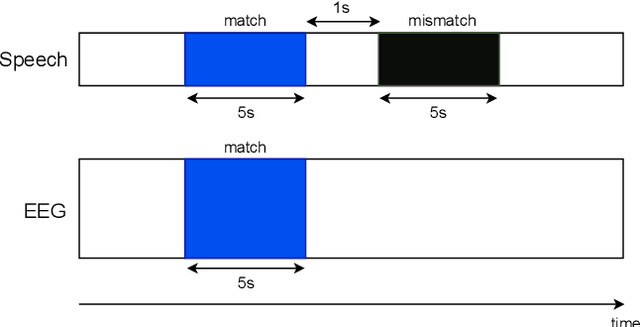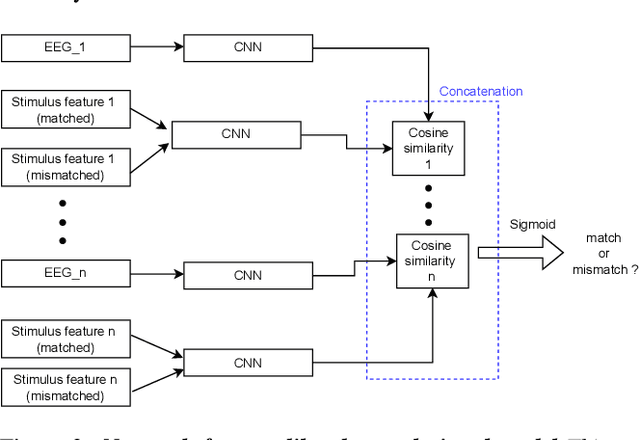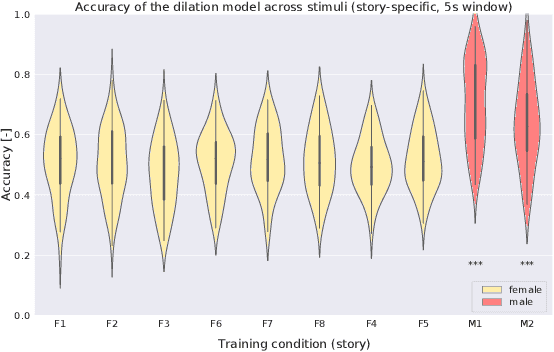Jonas Vanthornhout
Performance Modeling for Correlation-based Neural Decoding of Auditory Attention to Speech
Mar 12, 2025Abstract:Correlation-based auditory attention decoding (AAD) algorithms exploit neural tracking mechanisms to determine listener attention among competing speech sources via, e.g., electroencephalography signals. The correlation coefficients between the decoded neural responses and encoded speech stimuli of the different speakers then serve as AAD decision variables. A critical trade-off exists between the temporal resolution (the decision window length used to compute these correlations) and the AAD accuracy. This trade-off is typically characterized by evaluating AAD accuracy across multiple window lengths, leading to the performance curve. We propose a novel method to model this trade-off curve using labeled correlations from only a single decision window length. Our approach models the (un)attended correlations with a normal distribution after applying the Fisher transformation, enabling accurate AAD accuracy prediction across different window lengths. We validate the method on two distinct AAD implementations: a linear decoder and the non-linear VLAAI deep neural network, evaluated on separate datasets. Results show consistently low modeling errors of approximately 2 percent points, with 94% of true accuracies falling within estimated 95%-confidence intervals. The proposed method enables efficient performance curve modeling without extensive multi-window length evaluation, facilitating practical applications in, e.g., performance tracking in neuro-steered hearing devices to continuously adapt the system parameters over time.
Detecting Post-Stroke Aphasia Via Brain Responses to Speech in a Deep Learning Framework
Jan 17, 2024



Abstract:Aphasia, a language disorder primarily caused by a stroke, is traditionally diagnosed using behavioral language tests. However, these tests are time-consuming, require manual interpretation by trained clinicians, suffer from low ecological validity, and diagnosis can be biased by comorbid motor and cognitive problems present in aphasia. In this study, we introduce an automated screening tool for speech processing impairments in aphasia that relies on time-locked brain responses to speech, known as neural tracking, within a deep learning framework. We modeled electroencephalography (EEG) responses to acoustic, segmentation, and linguistic speech representations of a story using convolutional neural networks trained on a large sample of healthy participants, serving as a model for intact neural tracking of speech. Subsequently, we evaluated our models on an independent sample comprising 26 individuals with aphasia (IWA) and 22 healthy controls. Our results reveal decreased tracking of all speech representations in IWA. Utilizing a support vector machine classifier with neural tracking measures as input, we demonstrate high accuracy in aphasia detection at the individual level (85.42\%) in a time-efficient manner (requiring 9 minutes of EEG data). Given its high robustness, time efficiency, and generalizability to unseen data, our approach holds significant promise for clinical applications.
The role of vowel and consonant onsets in neural tracking of natural speech
Jul 31, 2023Abstract:To investigate how the auditory system processes natural speech, models have been created to relate the electroencephalography (EEG) signal of a person listening to speech to various representations of the speech. Mainly the speech envelope has been used, but also phonetic representations. We investigated to which degree of granularity phonetic representations can be related to the EEG signal. We used recorded EEG signals from 105 subjects while they listened to fairy tale stories. We utilized speech representations, including onset of any phone, vowel-consonant onsets, broad phonetic class (BPC) onsets, and narrow phonetic class (NPC) onsets, and related them to EEG using forward modeling and match-mismatch tasks. In forward modeling, we used a linear model to predict EEG from speech representations. In the match-mismatch task, we trained a long short term memory (LSTM) based model to determine which of two candidate speech segments matches with a given EEG segment. Our results show that vowel-consonant onsets outperform onsets of any phone in both tasks, which suggests that neural tracking of the vowel vs. consonant exists in the EEG to some degree. We also observed that vowel (syllable nucleus) onsets are better related to EEG compared to syllable onsets. Finally, our findings suggest that neural tracking previously thought to be associated with broad phonetic classes might actually originate from vowel-consonant onsets rather than the differentiation between different phonetic classes.
Detecting post-stroke aphasia using EEG-based neural envelope tracking of natural speech
Mar 14, 2023Abstract:[Objective]. After a stroke, one-third of patients suffer from aphasia, a language disorder that impairs communication ability. The standard behavioral tests used to diagnose aphasia are time-consuming and have low ecological validity. Neural tracking of the speech envelope is a promising tool for investigating brain responses to natural speech. The speech envelope is crucial for speech understanding, encompassing cues for processing linguistic units. In this study, we aimed to test the potential of the neural envelope tracking technique for detecting language impairments in individuals with aphasia (IWA). [Approach]. We recorded EEG from 27 IWA in the chronic phase after stroke and 22 controls while they listened to a story. We quantified neural envelope tracking in a broadband frequency range as well as in the delta, theta, alpha, beta, and gamma frequency bands using mutual information analysis. Besides group differences in neural tracking measures, we also tested its suitability for detecting aphasia using a Support Vector Machine (SVM) classifier. We further investigated the required recording length for the SVM to detect aphasia and to obtain reliable outcomes. [Results]. IWA displayed decreased neural envelope tracking compared to controls in the broad, delta, theta, and gamma band. Neural tracking in these frequency bands effectively captured aphasia at the individual level (SVM accuracy 84%, AUC 88%). High-accuracy and reliable detection could be obtained with 5-7 minutes of recording time. [Significance]. Our study shows that neural tracking of speech is an effective biomarker for aphasia. We demonstrated its potential as a diagnostic tool with high reliability, individual-level detection of aphasia, and time-efficient assessment. This work represents a significant step towards more automatic, objective, and ecologically valid assessments of language impairments in aphasia.
Relating EEG to continuous speech using deep neural networks: a review
Feb 06, 2023Abstract:Objective. When a person listens to continuous speech, a corresponding response is elicited in the brain and can be recorded using electroencephalography (EEG). Linear models are presently used to relate the EEG recording to the corresponding speech signal. The ability of linear models to find a mapping between these two signals is used as a measure of neural tracking of speech. Such models are limited as they assume linearity in the EEG-speech relationship, which omits the nonlinear dynamics of the brain. As an alternative, deep learning models have recently been used to relate EEG to continuous speech, especially in auditory attention decoding (AAD) and single-speech-source paradigms. Approach. This paper reviews and comments on deep-learning-based studies that relate EEG to continuous speech in AAD and single-speech-source paradigms. We point out recurrent methodological pitfalls and the need for a standard benchmark of model analysis. Main results. We gathered 28 studies. The main methodological issues we found are biased cross-validations, data leakage leading to over-fitted models, or disproportionate data size compared to the model's complexity. In addition, we address requirements for a standard benchmark model analysis, such as public datasets, common evaluation metrics, and good practices for the match-mismatch task. Significance. We are the first to present a review paper summarizing the main deep-learning-based studies that relate EEG to speech while addressing methodological pitfalls and important considerations for this newly expanding field. Our study is particularly relevant given the growing application of deep learning in EEG-speech decoding.
Relating the fundamental frequency of speech with EEG using a dilated convolutional network
Jul 05, 2022



Abstract:To investigate how speech is processed in the brain, we can model the relation between features of a natural speech signal and the corresponding recorded electroencephalogram (EEG). Usually, linear models are used in regression tasks. Either EEG is predicted, or speech is reconstructed, and the correlation between predicted and actual signal is used to measure the brain's decoding ability. However, given the nonlinear nature of the brain, the modeling ability of linear models is limited. Recent studies introduced nonlinear models to relate the speech envelope to EEG. We set out to include other features of speech that are not coded in the envelope, notably the fundamental frequency of the voice (f0). F0 is a higher-frequency feature primarily coded at the brainstem to midbrain level. We present a dilated-convolutional model to provide evidence of neural tracking of the f0. We show that a combination of f0 and the speech envelope improves the performance of a state-of-the-art envelope-based model. This suggests the dilated-convolutional model can extract non-redundant information from both f0 and the envelope. We also show the ability of the dilated-convolutional model to generalize to subjects not included during training. This latter finding will accelerate f0-based hearing diagnosis.
 Add to Chrome
Add to Chrome Add to Firefox
Add to Firefox Add to Edge
Add to Edge